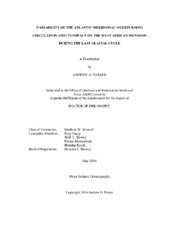| dc.description.abstract | The Atlantic Meridional Overturning Circulation is an important feature of Earth’s climate system that regulates hemispheric heat distribution. This dissertation takes an in-depth look at how the strength of this circulation changed during the course of the last ice age and explores the effects these variations had on Tropical Atlantic climate variability.
First, variability of AMOC during abrupt glacial climate events called Dansgaard-Oeschger Events (DO) is investigated. Using an established relationship between AMOC slowdown and a warming of subsurface waters across the tropical North Atlantic, a Mg/Ca-based temperature record reconstructed from the deep-dwelling foraminifera Globorotalia truncatulinoides is used to reconstruct subsurface temperatures in the southern Caribbean sea. This record reveals that during the cold phases of most Dansgaard-Oeschger Events, the subsurface of the Caribbean warmed in a manner consistent with a reduced AMOC during this time.
Then, the variability of the West African Monsoon (WAM) system during Heinrich Event 1 (H1) and the Younger Dryas (YD), periods of know AMOC reductions that occurred during the deglacial, is studied. Using the surface-dwelling foraminifera Globigerinoides ruber, Ba/Ca ratios were measured to reconstruct the deglacial discharge history of the Niger River. Ba/Ca ratios do not point to increased drought-like conditions during either the H1 or YD as suggested by previous studies based on Saharan dust accumulation records. Instead, the Ba/Ca ratios gradually increase after H1, reaching peak runoff conditions during the early Holocene. This gradual evolution of monsoonal rainfall across West Africa supports recent observations suggesting that deglacial reconstructions of dust from West Africa reflect changes in wind-strength rather than changes in aridity.
Modeling studies suggest that the subsurface around the Niger Delta is particularly sensitive to subsurface warming when AMOC slows. Thus, the deep-dwelling foraminifera Globorotalia crassaformis is used to reconstruct subsurface temperatures around the Niger Delta to compare with the deglacial Ba/Ca record of Niger River runoff from the same site. During H1 and the YD, the new Niger Delta subsurface temperature record suggests significant subsurface warming. These events are consistent with high-resolution model simulations that identify a strong negative correlation between AMOC strength and subsurface temperature around the Niger Delta. This subsurface warming may have reduced the land-sea thermal gradient, which is critical to monsoon development and significantly affected the strength of the monsoon during each event. | en |


